Nightmare on Elm Street 5: The Dream Child is a Slaughter Worth Bringing Your Daughter To
The grimmest Nightmare on Elm Street is an old-fashioned spookfest
Producer Robert Shaye was so disappointed by the response to 1989’s Nightmare on Elm Street 5: The Dream Child that he decided to end a series that was still a consistent money-maker with the next entry. A successful horror franchise is a license to print money, so it’s surprising that they ever stop when there is still moolah to be made.
Dream Warrior made just over twenty-two million dollars, which is less than half of Nightmare on Elm Street 4: The Dream Master’s gaudy gross.
Shaye wanted the franchise to end with a sequel that would be anti-Nightmare on Elm Street 5 in tone. Where Nightmare on Elm Street 5: The Dream Warrior was grim and intense, its follow-up was campy and ridiculous.
Nightmare on Elm Street 5: The Dream Child is unrelentingly dark, even for a series about a deeply scarred child murderer torturing and killing teenagers in their sleep.
It really plays up Freddy’s malevolent origins as the bastard son of a nun sexually assaulted by 100 maniacs. Freddy’s conception was a crime. He is the unholy offspring of gang rape, the hate that hate made.
Lisa Wilcox returns as Alice, a survivor of the previous movie. She wants to believe that Freddy Krueger has been defeated for the last and final time, but she’s haunted by images of a nun named Amanda Krueger, whose son she is all too familiar with.
Alice is the protagonist in a horror sequel, so of course, Freddy’s not out of commission. He may not technically be alive but he is up to mischief all the same.
The razor-clawed mass murderer with a weakness for one-liners has a concept of a plan to get back into the game. Freddy is using the dreams of Alice’s unborn child to continue his posthumous killing spree.
Alice is visited in her dream by Jacob (Whit Hertford), an older version of her unborn child and a vessel through which Freddy is trying to get his mojo back so that he can keep on killing. Hertford has an appropriately otherwordly presence. He’s a figure at once oddly ominous and weirdly wholesome.
Nightmare on Elm Street 5: The Dream Child is the Nightmare on Elm Street movie most rooted in horror history, in gothic imagery and Universal monsters. The concept of an evil, destructive fetus living inside the heroine proves a natural fit for Cronenbergian body horror.
Early in the film Alice’s boyfriend/baby daddy Dan (Danny Hassel) falls asleep while driving to Alice and his body and the motorcycle he’s riding become one. His body becomes metallic. He’s no longer a man but a malfunctioning metal machine, a doomed fusion of humanity and technology.
The concept of a hideously mutated baby that’s monstrous in its evil hearkens back to Larry Cohen’s It’s Alive franchise while making the final girl’s fetus a vessel of possible evil hearkens back to Rosemary’s Baby. A spiky metallic baby carriage, meanwhile, feels like H.R. Giger dreamed it up.
Englund does triple duty here as Freddy Krueger, a waiter and the mental hospital patient who presumably impregnated Amanda Krueger.
This adds to the sense that Freddy is everywhere and that his evil spirit pervades everything. Nightmare on Elm Street 5: The Dream Child takes it back to the beginning, to the inconceivable sin that resulted in Freddy Krueger’s unfortunate existence.
Freddy’s mother was a Godly woman who lost her faith but has a posthumous opportunity to redeem herself by helping the teens of Springwood eliminate her son.
Director Stephen Hopkins brings energy and style to the proceedings. Like the previous entry, this is a young movie, the work of someone in a hurry to show the world what they’re capable of.
Wes Craven was a revered fright-master when he wrote and directed Nightmare on Elm Street. The sequels would launch the directorial careers of their directors. It doesn’t matter if they made movies before they brought Freddy Krueger back to the big screen. Directing a Nightmare on Elm Street movie made them as filmmakers.
I had low expectations for Nightmare on Elm Street 5: The Dream due to its dire reputation and subpar box office. I was pleasantly surprised to discover that it’s an intense, nasty piece of work.
Every Nightmare on Elm Street movie has a kill that begs to be singled out for criticism. In The Dream Child, when a friend of Alice named Mark is introduced as a comic book fan enamored of a particular superhero, it becomes inevitable that his fandom will pay off in a deeply embarrassing, cringe fashion. It’s just a matter of how it will pay off in a way that brings great shame to the film, the franchise, and horror as a genre, if not film as a medium.
Sure enough, when Mark goes into a dream battle with Freddy, he’s in character and costume as his favorite superhero, and Freddy has morphed into “Super Freddy,” a comic book supervillain incarnation of the character that is realized onscreen by the hulking Michael Bailey Smith in comic book mode and by Noble Craig, a stuntman who lost two arms and a leg in Vietnam to play the character as he morphed from boring, regular old Freddy to Super Freddy.
It’s a kill that draws attention to itself in the worst way. It’s a bust due to the cornball character design but also because it has a much different tone than the rest of the film.
Nightmare on Elm Street 5: The Dream Child eschews camp as much as it is possible to do so in a movie about a crazed child murderer who shows off wicked skateboarding moves.
The fourth sequel to Wes Craven’s horror classic deserves an extra star for the title of Iron Maiden’s theme song, “Bring Your Daughter to the Slaughter.” That name alone justifies the film’s bleak existence.
Nightmare on Elm Street 5: The Dream Child is a slaughter worth bringing your daughter to. She’ll have a nice time, and you’ll have a positive bonding experience. In that respect, this is a family movie, albeit one about two very different kinds of families in the Johnsons and the Kruegers.




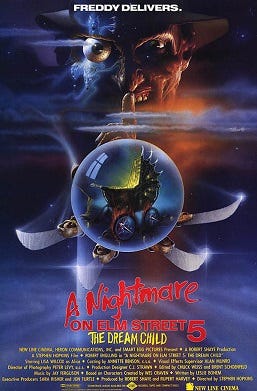
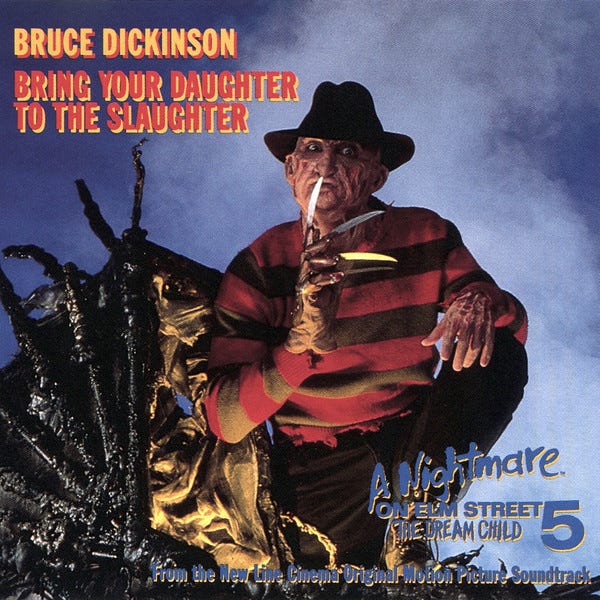
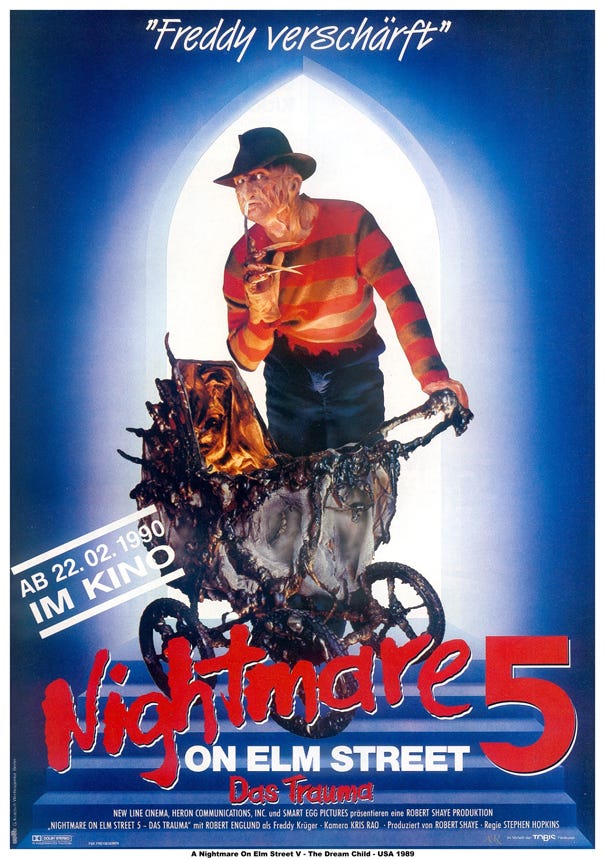
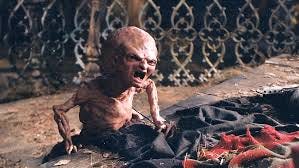

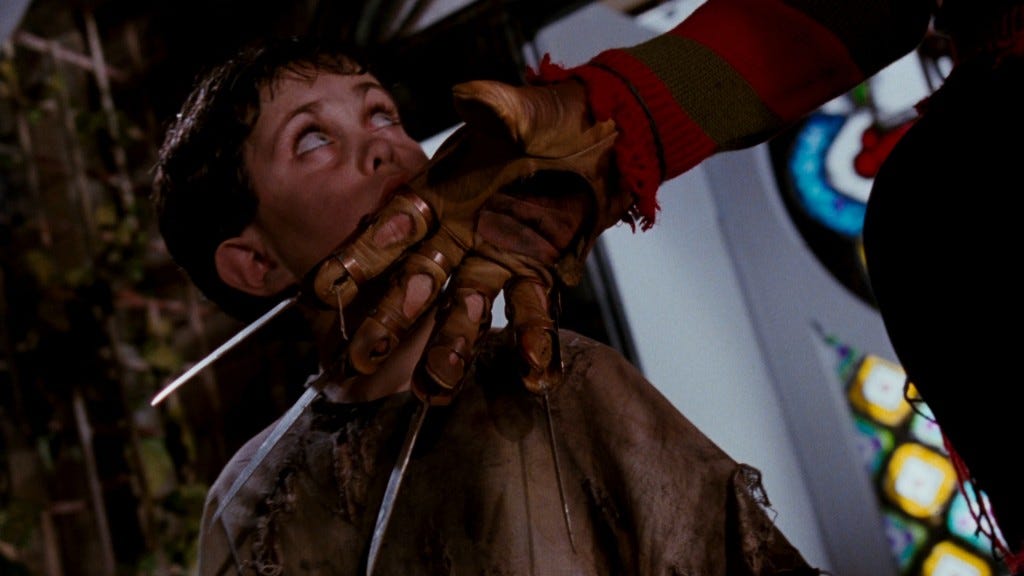


Pleasantly surprised to see that I’m not the only one who thinks this movie is unfairly overhated. It’s a good time, roughly on par with its predecessors, if not as robust as Dream Master.
There are a couple of references to (The) Dream Warrior, early in the article that I think I probably not meant to be referring to A Nightmare on Elm Street 3: Dream Warriors.